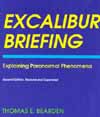|
KINDLING EFFECT
G.V. Goddard and his associates in 1969 reported a peculiar kindling effect generated by repeated, periodic, low-intensity stimulation of the limbic region of
mammalian brains. A sustained periodic signal input to the brain and central
nerv ous system eventually sets up a cumulative resonance which increases in
magni tude until the entire organism is in sympathetic resonance.
A laboratory rat at first continues to explore its environment in a normal manner when it is subjected to kindling. But after repeated stimulation at the same intensity, the rat will begin to rear up and its forelimbs will convulse. Eventually these bursts of electrical activity induce similar patterns in nearby brain regions, and the threshold becomes progressively lowered. Stimulation progresses to the amygdala, to the amygdala on the other side of the brain, to the hippocampus, to the occipital cortex, and finally to the frontal cortex. Kindling can start only in the limbic structures.
While kindling was originally thought to be a model of
epilepsy, John Gaito of York University has reported that a different mechanism
is apparently involved since the amino acid, taurine, which suppresses epileptic
seizures in laboratory animals, does not prevent phenomena caused by kindling.
Also, kindling apparently causes permanent changes in the neural circuitry.
Pulsed repetitions of telepathic senders have also been shown to increase the
reception of telepathic messages. Thus the kindling effect apparently
applies to the paranormal channel as well as to more orthodox transmission
channels. (For further details, see "Kindling, once epilepsy model,
may relate to kundalini," Brain/ Mind Bulletin, Vol. 2, No.7,
February 21, 1977; pp. 1-2.)
The kindling mechanism is a far more general mechanism than
epilepsy researchers have realized. Coherent time collection of bioenergy
in one bioframe "kindles" toward the threshold of the next bioframe,
which has a fixed threshold. When sufficient kindling occurs to reach the
threshold, automatic orthogonal rotation of the kindled bioenergy occurs into
the next frame. There it simply constitutes the kindling or superposition
of the imperceivable subquantum state into the perceivable quantum state.
This is the mechanism whereby one kind of field can be turned into another.
E.g., thought energy (third biofield) can be kindled into second biofield
(flux), which can be kindled into first biofield (electromagnetic energy), which
can be kindled into zeroth biofield (matter).
Next
Chapter |
